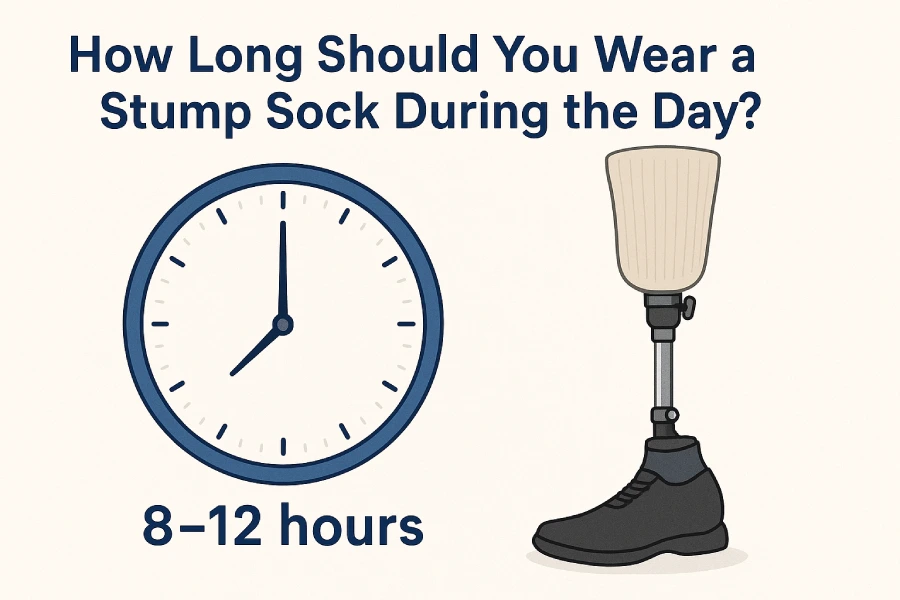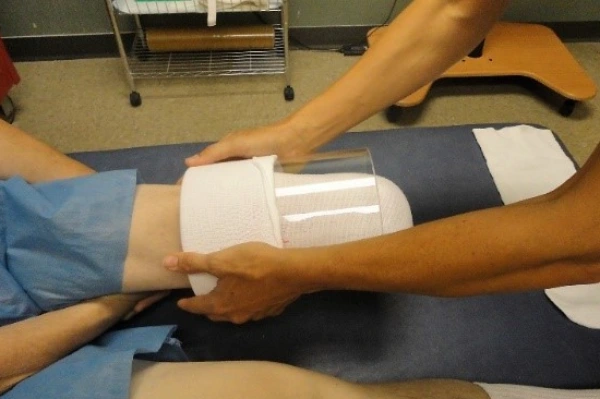Every amputee wants comfort, stability, and protection — and that’s exactly what a good stump sock provides. But here’s a question that comes up almost daily in prosthetic forums and clinic visits:
Can you wear your stump sock all day and even while sleeping at night?
It’s an important question, because while stump socks are designed for all-day comfort, wearing them too long — especially overnight — can sometimes cause more harm than good. Let’s look at how long is safe, what the risks are, and how to help your customers form healthy habits.
What Is a Stump Sock and Why It Matters

A stump sock (also known as a residual limb sock) is designed to be worn over the amputated limb to protect the skin, absorb moisture, and improve prosthetic comfort. It serves three main purposes:
- Moisture management: It wicks sweat and keeps the limb dry, preventing skin irritation.
- Pressure cushioning: It reduces friction and pressure between the prosthetic socket and skin.
- Fit adjustment: It helps users fine-tune prosthesis fit as the limb changes volume throughout the day.
High-quality stump socks are made from soft, breathable, and hypoallergenic materials such as cotton, wool blends, or medical-grade synthetics. Some advanced models even include compression zones or antibacterial fibers to support circulation and hygiene.
How Long Should You Wear a Stump Sock During the Day?

In most cases, stump socks are meant for daytime wear only. They’re built to handle 8–12 hours of continuous use — the average time someone spends active with their prosthesis.
During the day, your body temperature, sweat rate, and movement help circulate air inside the socket. This keeps moisture manageable, provided the sock is made of breathable fibers such as cotton, wool, bamboo, or advanced synthetics.
However, once a person crosses the 12-hour mark, several problems can start to appear:
- The sock becomes saturated with moisture and bacteria.
- Skin loses its ability to breathe freely.
- The liner and socket may start to slip, causing friction burns or blisters.
That’s why daily changing and cleaning are essential. A fresh stump sock every morning prevents buildup and keeps the limb environment stable.
Can You Sleep with a Stump Sock On? (And How Long Is Too Long?)

Now comes the big question — is it safe to wear your stump sock overnight?
In general, no, unless a medical professional specifically instructs it. Here’s why:
- Circulation changes during sleep. When lying flat, blood flow and pressure distribution shift. A stump sock that fits well upright can become restrictive when you’re resting.
- Heat and moisture accumulate. Your body temperature rises slightly at night, and without airflow, dampness builds up faster, creating the perfect environment for bacteria.
- Skin maceration risk. Prolonged contact with moisture softens skin, making it prone to irritation or even infection.
In short: daytime use = good; 24-hour use = risky.
🕒 So How Long Is Safe?
For most users, the maximum recommended wear time is 12–16 hours. Anything beyond that should involve removing the sock, washing it, and letting the limb breathe for a few hours before reapplying.
If your customers insist on nighttime use — maybe for warmth or compression — remind them to consult their prosthetist first. A clinician might prescribe a specialized night stump sock or shrinker sock designed for controlled pressure during rest.
If you’re unsure which product is right for day vs night, compare them here: Stump Sock vs Shrinker Sock
Skin Care and Hygiene: The Key to Safe Daily Wear

Proper skin care goes hand in hand with stump sock use. Many end users — especially new amputees — underestimate this part. Educating them improves satisfaction and reduces product returns.
Here’s what you can share:
- Clean skin daily: Use gentle, fragrance-free soap and pat dry.
- Avoid heavy creams or lotions under the sock; they can trap heat.
- Use breathable, medical-grade materials: Cotton or merino wool socks offer natural moisture control.
- Store socks properly: In a clean, dry place away from direct sunlight.
If your brand offers socks with antimicrobial or copper fibers, highlight those features as value points — they actively help reduce odor and bacterial growth for all-day comfort. Experiencing discomfort or sweating issues? Learn more in Why Is My Stump Sweating or Itching with the Sock On?
When Overnight Wear Might Be Appropriate

There are exceptions — and they’re important to address carefully.
Some amputees are advised to wear stump socks overnight to control swelling or post-surgical changes in limb shape. In these cases, the socks used are medical-grade shrinker socks or low-compression stump socks, not regular daily-use ones.
These are designed to:
- Promote gentle compression.
- Reduce residual limb swelling.
- Help shape the stump during early healing.
However, this should always be prescribed and supervised by a healthcare professional. If your brand supplies to clinics or hospitals, you can highlight this category of specialized socks as part of your medical range — emphasizing the distinction between “daily-use” and “therapeutic-use” stump socks.
Helping Customers Choose Wisely

Many end-users don’t know that the wrong sock or wearing habits can lead to discomfort and even infection. As a supplier or brand, you can help guide them toward safer, more effective use by:
- Educating through packaging or product inserts. Include clear instructions on daily wear duration and cleaning tips.
- Offering different sock types for different needs. For example:
- Light, breathable stump socks for daily prosthetic use.
- Antimicrobial or silver-infused socks for users with high sweat issues.
- Special compression stump socks for post-surgery recovery.
- Encouraging proper rotation. Recommending at least three pairs allows one to wear, one to wash, and one to dry — maintaining hygiene and convenience.
This kind of education not only builds trust but also reduces product returns and improves long-term customer satisfaction.
Key Takeaways for Safe Wear
Let’s sum up the main points clearly:
- Stump socks are safe and beneficial for daytime use (8–12 hours).
- Avoid wearing them overnight unless prescribed by a doctor.
- Change and wash them daily to prevent skin issues.
- Specialized “shrinker socks” are different — suitable for controlled compression during rest.
- Retailers and brands should include clear usage guidance to protect customers and enhance brand credibility.
FAQ: Stump Sock Wear and Care Questions Answered
Why does my stump sweat so much inside the sock?
Excessive sweating often happens when the sock fabric isn’t breathable enough or fits too tightly. Try switching to a moisture-wicking stump sock made from bamboo or wool. Washing your socks daily and keeping an extra pair on hand can also help reduce odor and discomfort.
Is it safe to sleep with a stump sock on?
Generally, sleeping with a stump sock on is not recommended. Overnight wear can restrict blood flow and create a damp environment that leads to irritation. Only follow this routine if your prosthetist prescribes a low-compression or shrinker sock specifically for nighttime use.
How many stump socks should I have?
Most users should keep at least three pairs — one to wear, one to wash, and one to dry. Having multiple pairs ensures proper hygiene and comfort every day. Rotating them also helps prolong the lifespan of each sock.
How often should stump socks be replaced?
Replace your stump socks every 3 to 6 months, depending on wear frequency and washing habits. Over time, the fibers lose elasticity and absorbency, affecting both comfort and fit. If the sock feels thin or loose, it’s time for a new one.
What materials are best for stump socks?
Breathable materials like bamboo, merino wool, and silver-infused yarns are ideal. These fabrics wick moisture, prevent odors, and reduce bacterial growth. Synthetic blends can also work well for durability and elasticity.
Why Work with Max Hosiery

At Max Hosiery, our team focuses on producing reliable, well-fitting stump socks for clinics, prosthetic brands, and medical suppliers around the world.
Our socks are crafted with high-performance materials like bamboo, silver yarn, and merino wool — chosen for their softness, moisture control, and long-lasting quality. Every pair is designed to support healthy skin and consistent comfort throughout daily wear.
We’re here to help you offer products that patients truly feel comfortable wearing — day after day.
New to prosthetic socks? Start here: What Is a Stump Sock?
